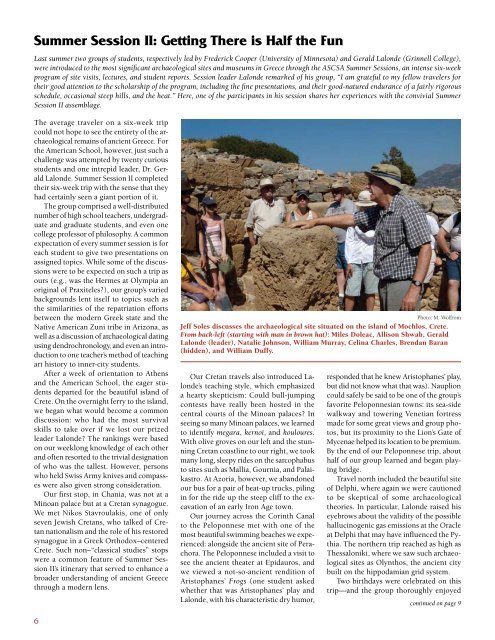2009 edition, nos. 60/61 - The American School of Classical Studies ...
2009 edition, nos. 60/61 - The American School of Classical Studies ...
2009 edition, nos. 60/61 - The American School of Classical Studies ...
Create successful ePaper yourself
Turn your PDF publications into a flip-book with our unique Google optimized e-Paper software.
summer session II: Getting there is half the Fun<br />
Last summer two groups <strong>of</strong> students, respectively led by Frederick Cooper (University <strong>of</strong> Minnesota) and Gerald Lalonde (Grinnell College),<br />
were introduced to the most significant archaeological sites and museums in Greece through the ASCSA Summer Sessions, an intense six-week<br />
program <strong>of</strong> site visits, lectures, and student reports. Session leader Lalonde remarked <strong>of</strong> his group, “I am grateful to my fellow travelers for<br />
their good attention to the scholarship <strong>of</strong> the program, including the fine presentations, and their good-natured endurance <strong>of</strong> a fairly rigorous<br />
schedule, occasional steep hills, and the heat.” Here, one <strong>of</strong> the participants in his session shares her experiences with the convivial Summer<br />
Session II assemblage.<br />
<strong>The</strong> average traveler on a six-week trip<br />
could not hope to see the entirety <strong>of</strong> the archaeological<br />
remains <strong>of</strong> ancient Greece. For<br />
the <strong>American</strong> <strong>School</strong>, however, just such a<br />
challenge was attempted by twenty curious<br />
students and one intrepid leader, Dr. Gerald<br />
Lalonde. Summer Session II completed<br />
their six-week trip with the sense that they<br />
had certainly seen a giant portion <strong>of</strong> it.<br />
<strong>The</strong> group comprised a well-distributed<br />
number <strong>of</strong> high school teachers, undergraduate<br />
and graduate students, and even one<br />
college pr<strong>of</strong>essor <strong>of</strong> philosophy. A common<br />
expectation <strong>of</strong> every summer session is for<br />
each student to give two presentations on<br />
assigned topics. While some <strong>of</strong> the discussions<br />
were to be expected on such a trip as<br />
ours (e.g., was the Hermes at Olympia an<br />
original <strong>of</strong> Praxiteles?), our group’s varied<br />
backgrounds lent itself to topics such as<br />
the similarities <strong>of</strong> the repatriation efforts<br />
between the modern Greek state and the<br />
Native <strong>American</strong> Zuni tribe in Arizona, as<br />
well as a discussion <strong>of</strong> archaeological dating<br />
using dendrochronology, and even an introduction<br />
to one teacher’s method <strong>of</strong> teaching<br />
art history to inner-city students.<br />
After a week <strong>of</strong> orientation to Athens<br />
and the <strong>American</strong> <strong>School</strong>, the eager students<br />
departed for the beautiful island <strong>of</strong><br />
Crete. On the overnight ferry to the island,<br />
we began what would become a common<br />
discussion: who had the most survival<br />
skills to take over if we lost our prized<br />
leader Lalonde? <strong>The</strong> rankings were based<br />
on our weeklong knowledge <strong>of</strong> each other<br />
and <strong>of</strong>ten resorted to the trivial designation<br />
<strong>of</strong> who was the tallest. However, persons<br />
who held Swiss Army knives and compasses<br />
were also given strong consideration.<br />
Our first stop, in Chania, was not at a<br />
Minoan palace but at a Cretan synagogue.<br />
We met Nikos Stavroulakis, one <strong>of</strong> only<br />
seven Jewish Cretans, who talked <strong>of</strong> Cretan<br />
nationalism and the role <strong>of</strong> his restored<br />
synagogue in a Greek Orthodox–centered<br />
Crete. Such non–“classical studies” stops<br />
were a common feature <strong>of</strong> Summer Session<br />
II’s itinerary that served to enhance a<br />
broader understanding <strong>of</strong> ancient Greece<br />
through a modern lens.<br />
6<br />
Photo: M. Wolfrom<br />
Jeff Soles discusses the archaeological site situated on the island <strong>of</strong> Mochlos, Crete.<br />
From back-left (starting with man in brown hat): Miles Doleac, Allison Shwab, Gerald<br />
Lalonde (leader), Natalie Johnson, William Murray, Celina Charles, Brendan Baran<br />
(hidden), and William Duffy.<br />
Our Cretan travels also introduced Lalonde’s<br />
teaching style, which emphasized<br />
a hearty skepticism: Could bull-jumping<br />
contests have really been hosted in the<br />
central courts <strong>of</strong> the Minoan palaces? In<br />
seeing so many Minoan palaces, we learned<br />
to identify megara, kernoi, and kouloures.<br />
With olive groves on our left and the stunning<br />
Cretan coastline to our right, we took<br />
many long, sleepy rides on the sarcophabus<br />
to sites such as Mallia, Gournia, and Palaikastro.<br />
At Azoria, however, we abandoned<br />
our bus for a pair <strong>of</strong> beat-up trucks, piling<br />
in for the ride up the steep cliff to the excavation<br />
<strong>of</strong> an early Iron Age town.<br />
Our journey across the Corinth Canal<br />
to the Peloponnese met with one <strong>of</strong> the<br />
most beautiful swimming beaches we experienced:<br />
alongside the ancient site <strong>of</strong> Perachora.<br />
<strong>The</strong> Peloponnese included a visit to<br />
see the ancient theater at Epidauros, and<br />
we viewed a not-so-ancient rendition <strong>of</strong><br />
Aristophanes’ Frogs (one student asked<br />
whether that was Aristophanes’ play and<br />
Lalonde, with his characteristic dry humor,<br />
responded that he knew Aristophanes’ play,<br />
but did not know what that was). Nauplion<br />
could safely be said to be one <strong>of</strong> the group’s<br />
favorite Peloponnesian towns: its sea-side<br />
walkway and towering Venetian fortress<br />
made for some great views and group photos,<br />
but its proximity to the Lion’s Gate <strong>of</strong><br />
Mycenae helped its location to be premium.<br />
By the end <strong>of</strong> our Peloponnese trip, about<br />
half <strong>of</strong> our group learned and began playing<br />
bridge.<br />
Travel north included the beautiful site<br />
<strong>of</strong> Delphi, where again we were cautioned<br />
to be skeptical <strong>of</strong> some archaeological<br />
theories. In particular, Lalonde raised his<br />
eyebrows about the validity <strong>of</strong> the possible<br />
hallucinogenic gas emissions at the Oracle<br />
at Delphi that may have influenced the Pythia.<br />
<strong>The</strong> northern trip reached as high as<br />
<strong>The</strong>ssaloniki, where we saw such archaeological<br />
sites as Olynthos, the ancient city<br />
built on the hippodamian grid system.<br />
Two birthdays were celebrated on this<br />
trip—and the group thoroughly enjoyed<br />
continued on page 9

















